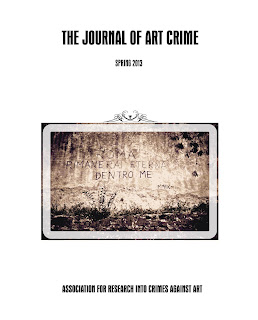Greek forensic archaeologist Christos Tsirogiannis writes "Something is Confidential in the State of Christie's" in the Spring 2013 issue of The Journal of Art Crime.
This article is a report on the appearance of "toxic" antiquities, offered by Christie's at auctions in London and New York during 2012, which have now been identified in the confiscated archives of the convicted dealers Giacomo Medici and Robin Symes. The research aims to reconstruct the true modern story and full collecting history of seven antiquities: a bronze board, a terracotta ship, a pair of kraters, a terracotta statue of a boy, a kylix, and a marble head. New evidence in each case presents a different version of the collecting history from that offered by Christie's. This paper, going in order through the Christie's 2012 antiquities auctions, demonstrates that in many instances the market uses the term "confidentiality" to conceal the identities of its disgraced members, and to put an end to academic or other research for the truth. It also reveals that most of the dealers, galleries, collectors and auction houses listed by Christie's as previous owners have been involved in several other cases of illicit antiquities.
 |
| Christos Tsirogiannis |
Mr. Tsirogiannis writes in the introduction to his article:
In 1995, the Italian and Swiss authorities confiscated the Giacomo Medici archive in the Free Port of Geneva (Watson & Todeschini 2007:20). Later, in 2002, the same authorities confiscated the Gianfranco Becchina archive in Basel (Watson & Todeschini 2007:292). In 2006, during a raid at a villa complex maintained by the Papadimitriou family (descendants of the antiquities dealer the late Christos Michaelides), the Greek authorities confiscated the archive of the top antiquities dealers of modern times, Robin Symes and Christos Michaelides (Zirganos 2006b:44, Zirganos in Watson and Todeschini 2007:316-317). These three archives -- and, especially, the combined information they include (almost exclusively after 1972) -- provide an unprecedented insight into the international antiquities market. Research in the archives uncovers the ways in which thousands of looted antiquities, from all over the world, were smuggled by middlemen and "laundered" by auction houses and dealers, before being acquired by museums and private collectors, in contravention of the guidelines of the 1970 UNESCO Convention and the 1970 ICOM statement on Ethics of Acquisitions.
Since 2005, the Italian authorities, based on evidence from these three archives, have repatriated about 200 antiquities, from the University of Virginia (Ford 2008; Isman 2008:25, Isman 2009:87-88), Boston Museum of Fine Arts (Gill & Chippindale 2006; silver 2010:263-264), J. Paul Getty Museum (in three different occasions, for the first see Gill & Chippindale 2007; Gill:2010:105-106; Silver 2010:268; for the second and third see Gill 2012b and Ng & Felch 2013, respectively), Metropolitan Museum of Art (in two different occasions, for the first see Silver 2010:252-253; Gill 2010:106; for the second see Gill 2012a:64), Princeton University Museum of Art (in 2 different occasions, for the first see Gill and Chippindale 2007:224-225; Gill 2009a; Gill 2010:106-107; for the second see Gill 2012: Felch 2012a), Cleveland Museum of Art (Gill 2010:105), the Shelby White/Leon Levy private collection (Gill 2010:108; Silver 2010:272), Royal-Athena Galleries (dealer Jerome Eisenberg, see Gill 2010:107-108; Isman in Godart, De Caro & Gavrili 2008:24), the Minneapolis Institute of Art (Padgett 1983-86 [1991]; Padgett 1984; Gill 2009b:85; Gill & Tsirogiannis 2011:32; Boehm 2011) and the Dietrich Von Bothmer private collection of vase fragments in the Metropolitan Museum of Art (Gill 2012a:64). Recently, Toledo Museum of Art agreed to return an Etruscan Hydria to Italy (The United States Attorney's Office 2012), while Dallas Museum of Art announced the return of 5 antiquities to Italy and 1 antiquity to Turkey (Richter 2012; Gill 2013b). From the numerous antiquities depicted in the three confiscated archives, the Greek authorities have managed to repatriate only 2 so far, both from the Getty Museum in 2007 (Gill & Chippindale 2007:205, 208; Felch & Frammolino 2011:290).
Following their repatriation, these antiquities were published and exhibited with acknowledgement of their looted past (Godart & De Caro 2007; Godart, De Caro & Gavrili 2008), revealing the true nature of most antiquities in the confiscated archives. So incriminating is the evidence in the three archives presented by the authorities during the negotiations for each object that in no case has any museum, private collection or dealer tried to defend their acquisitions in court. The reason is that the photographic evidence presents, in most cases, the oldest part of the object's modern collecting history ("provenance," its first appearance after being looted; smashed and covered with soil, or recently restored, without any previously documented legal collecting history. An attempt to defend their illicit acquisitions during a court case would have brought (apart from the inevitable surrender of the object(s)) a long-lasting negative publicity for the museums, private collectors and dealers involved, additional embarrassment, an extra financial loss and the possibility that their and others' involvement in more cases of looted antiquities would be revealed. The subsequent returns in 2012 and 2013 from the Getty Museum to Italy and from the Metropolitan Museum of Art to Italy in 2012 prove that point.
Although each repatriation case attracted massive media attention (Miles, 2008:357; Felch & Frammolino 2011:284) and non-specialists around the world began to be informed about the true nature of the modern international antiquities market, the market itself reacted badly. Having missed the 1970 UNESCO opportunity to reform, the market is now losing a second chance to change its attitude, since it is continuing to offer antiquities depicted in the three confiscated archives (Gill & Tsirogiannis 2011).The ninth issue of The Journal of Art Crime, edited by Noah Charney and published by ARCA, is available electronically (pdf) and in print via subscription and Amazon.com. The Associate Editor is Marc Balcells (ARCA '11), Graduate Teaching Fellow, Department of Political Science, John Jay College of Criminal Justice -- The City University of New York.










